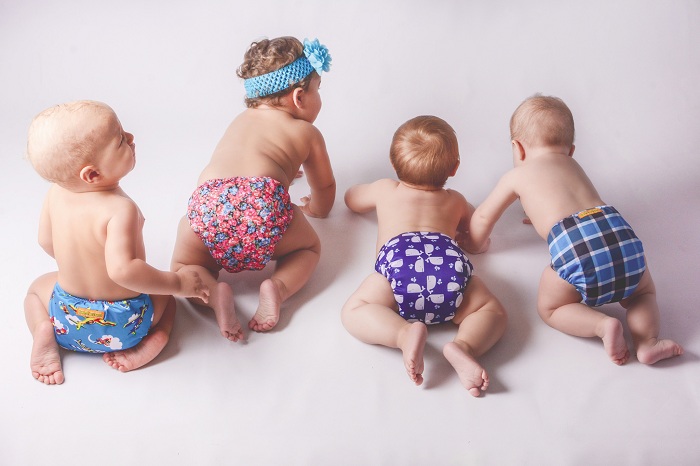Diapers are a part of the parenting experience whether they are made of cloth or are disposable. Babies can may need to change diapers more frequently per day till the time they begin potty training.
When it comes to choosing the right diaper, it may be a combination of what suits your little one, and your budget.
Cloth diapers are available in cotton, flannel or Terry cloth and come either as refolded pieces of cloth liners or as an all in one. While cloth diapers may look as an initial great investment they are a cheaper option as compared to the disposables. Plus, the fact that they are less absorbent makes ensures that they are changed frequently leading to a fewer rashes.
While disposable diapers look convenient as they cinch to change thanks to the strips attached to their back panel that can fasten in front. You pick a size based on your baby’s weight and age for the best fit. You can toss them while travelling without having to carry them back home. They may look ultra-absorbent due to their inner lining that deals with the wetness.
Here’s what you need to know when it comes to cloth diapers and why they make the right choice for the baby and you.
Read- Monitor Your Health and Stay Fit During Your Pregnancy With These 4 Easy Steps!
The cloth diapers of today come in a number of styles and have features such as waterproof cover or an absorbent insert or layer. While in some cases these inserts are snapped to the cover others might be fitted into pockets.
The material for the layers of a cloth diaper maybe derived naturally such as from plants or animals or maybe synthetic which is a less expensive option. The type of material used impacts the diaper’s absorbency.
Speaking about the diaper covers, they are typically constructed of the following:
-TPU or thermoplastic polyurethane: These covers are waterproof and affordable, however, they may not be breathable in particular.
-Cotton: TPU can be used along with cotton for softness, however, they may be prone to leakages.
-Fleece; Another form of polyester, it allows for more airway circulation.
-Wool: Its covers are breathable and absorbent.
-Microfibre: These covers are made of polyester as well.
The inserts used in diapers also come in varied materials such as cotton, hemp, bamboo, microfibre and synthetics. While some inserts are disposable they can be a good option for patrons who look at cloth diapers as an inexpensive option.
Type of cloth diapers
Table of Contents
There are four major type of cloth diapers, the one you choose depends upon what you’re looking for.
1. Pre-folds and covers
This can be considered as an updated version used by your grandmother. It consists of an absorbent inner layer and a waterproof cover. The inner layer is usually a cotton cloth. This type of diaper is usually the least expensive mostly because you can reuse it for multiple changes. The downside to using this type is that they are complicated to learn and you’ll need to learn a little diaper folding technique.
2. Fitteds
They are similar to pre-folds and can be made of cotton, hemp, bamboo or synthetic materials. They don’t have any type of closure and are a piece of absorbent material which are sewn into a contoured shape that fits into a cover. You can place the contour in the cover and then put the diaper on your baby in one piece.
3. Pockets
They consist of two parts, a diaper which includes an inner later and an outer waterproof layer with a pocket opening in between. To use the pocket, you can stuff the insert into the pocket and then put the diaper on your baby. They are also convenient for babysitters, once you’ve stuffed the insert, putting a pocket on is exactly like putting on a disposable, with no special knowledge required.
4. All-in-ones
Just as the name implies, all-in-ones include the entire diaper in a single place. In these type of diapers, the waterproof, absorbent, and wicking layer all are sewn together, which means that using an all-in-one is as simple as using as a disposable. There’s no stuffing, folding or confusion. However, the difference lies that you toss them in the dirties rather than throwing them in trash.
Evaluating the cloth diapers
-Cloth diapers are reusable and eco-friendly:
As an average child may go-onto use thousands of diapers in his or her life, the amount of disposed diapers are likely to have an impact on the environment. All the chemicals used in the process are to pollute the environment. And then comes, cloth diapers which can be used over and over again with a safe detergent. There isn’t a contest here.
-Compared to the disposable diapers they are gentler on the baby’s sensitive skin
With nasty chemicals used in disposables, they can be a cause of allergic reactions and rashes for your baby. Cloth diapers may help protect your baby from such troubles.
-With adjustable feature
Due to their adjustable features and waterproof bands they help keep the leaks in
Cloth diapers now also comes with velcro and snap closures which make changing time just as quick and easy as compared to the disposable ones.
How to pick up a brand of cloth diapers
We’d strongly suggest knowing the exact kind of diaper you’re looking for at first. Just popping a question and asking google, ‘What kind of cloth diaper is best?’ will get you a million recommendations for the the pocket diaper brands. Once you have a style or two in mind, you know that your’e going to invest in newborn diapers or are just going to jump to one-size diapers. By staying informed you can also route to communities for their preferred brand of diapers and get a lot of relevant recommendations.
General care for cloth diapers
Always make sure to check the manufacturer’s instructions. The general procedure is to dump the solid waste in the toilet, and rinse both inserts & cover in cold water, followed by running it through a midl detergent & bleach solution prior to giving it a proper wash. Make sure to wash the cloth diapers separately from your regular laundry.
Health and comfort of the baby
Make sure to check on your baby as leaving a soiled diaper can increase the risk of a diaper rash.







